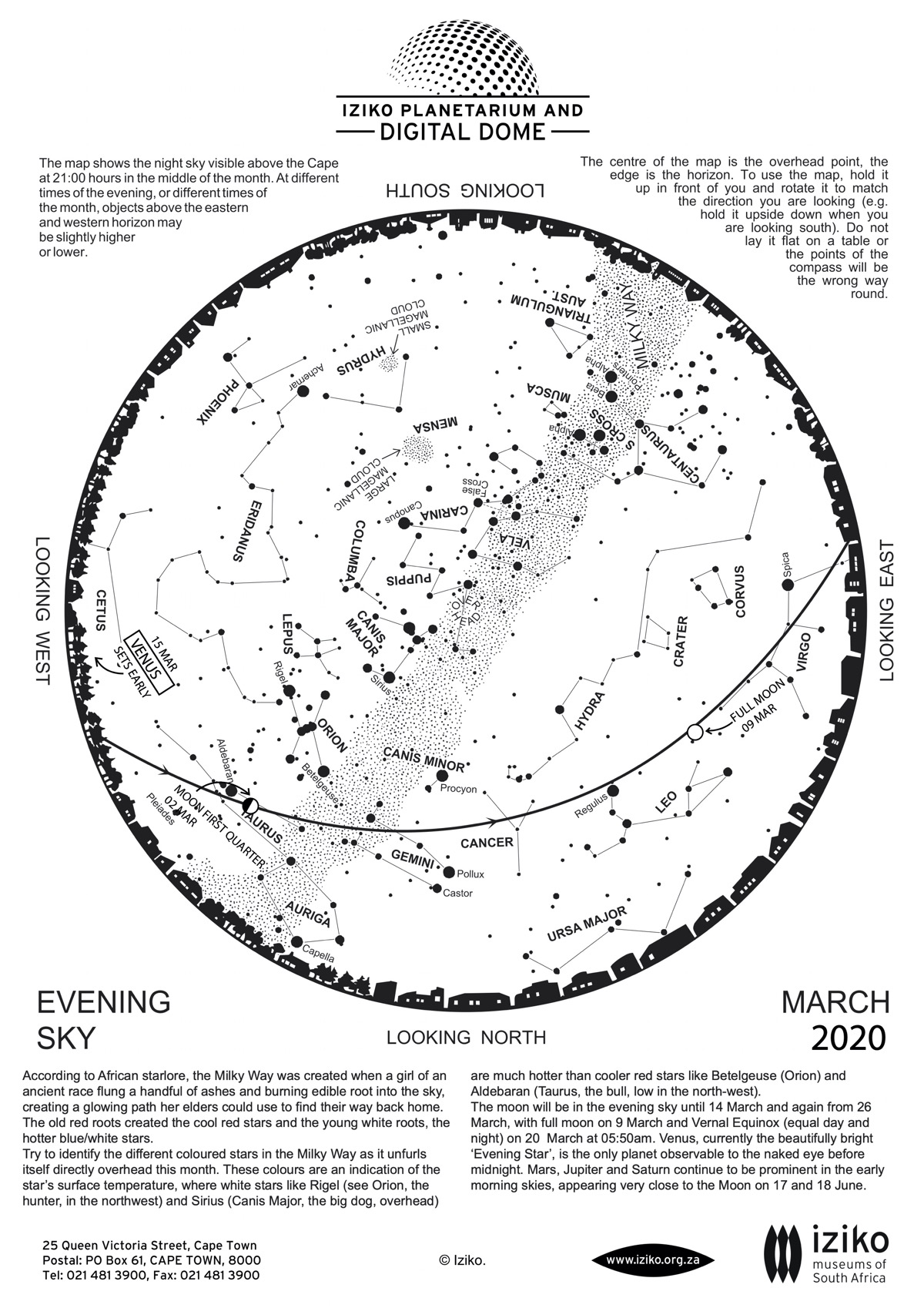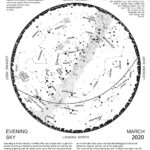
04 Jul Whats Up – July 2020
In a nutshell…
Moon
| Date | Time | Phase |
|---|---|---|
| 05/07 | 06h44 | Full Moon |
| 13/07 | 01h29 | Last Quarter |
| 20/07 | 19h33 | New Moon |
| 27/07 | 14h32 | First Quarter |
Moon – Earth Relations
Perigee: 368 400 km on the 25/07 at 06h54
Apogee: 404 200 km on the 12/07 at 21h27
Sun- Earth- Moon relations
Penumbral Eclipse on the 5th of July (starts at 05h07, reaches mid eclipse at 06h30 and ends at 07h52)
Planet Visibility
Jupiter and Saturn in Sagittarius visible in the evening sky and at dawn
Mars near Pisces visible at dawn
Venus near Taurus visible at dawn
Mercury near Gemini visible at dawn
Dwarf planets: Pluto reaches opposition on the 16th of July
Asteroids: Pallas (Asteroid 2) at opposition on the 15th of July
Meteors
June Lyrids: 11th to 21st of June; 16th – maximum
theta-Ophiuchids: 8th – 16th of June; 13th – maximum
Some easy to identify bright stars
Antares: red supergiant in Scorpius
Arcturus: red giant in Boötes
Spica: brightest bluish-white star in Virgo
Canopus: yellowish-white star in Carina
Altair: a white star, brightest in Aquila
Regulus: blue–white star and the brightest star in Leo
The Pointers: Alpha and Beta Centauri
Sun and Moon
The Full Moon occurs on the 5th of July at 06h44. The Last Quarter Moon falls on the 13th of July at 01h29 and the New Moon occurs at 19h33 on the 20th of July. The First Quarter falls on the 27th of July at 14h32. The Moon will be at perigee (closest approach to Earth) at a distance of about 368 400 km on the 25th of July at 06h54. On the 12th of July at 21h27, the Moon will be at apogee (furthest from Earth) at a distance of about 404 200 km.
A penumbral lunar eclipse will occur on the 5th of July and will be visible to Southern Africa. It will commence from about 05h07, the maximum eclipse occurs at 06h30 and ends at 07h52.
Planetary and Other Events – Morning and Evening
Only Jupiter and Saturn are visible in the evening sky and can be observed near the stars of the constellation, Sagittarius. The Moon will be near Jupiter on the 5th of July and both Saturn and Jupiter will be near the Moon on the 6th of July. Jupiter and Saturn reach opposition on the 14th and 21st of July respectively and are therefore best placed for observation. This month presents an opportunity to see all the five naked eye planets in the morning sky. At the beginning of the month, Venus near the stars of the constellation Taurus, Mars near the stars of the constellation Pisces, Jupiter and Saturn near the stars of Sagittarius can all be seen at dawn. The smallest planet Mercury joins the quartet of planets by mid-month and can be seen at dawn low in the east near the stars of Gemini. The Moon is near Mars on the 11th of July and it is near Venus on the 17th of July.
The dwarf planet Pluto reaches opposition on the 16th of July and is therefore best positioned for observation. Pallas 9 (Asteroid 2) reaches opposition on the 15th of July and is located near the stars of Sagittarius.
Four meteor showers are active in July. Of these, observing prospects are good for the July Phoenicids. The July Phoenicids meteor shower is active from the 10th July to the 16th July, peaking on the 13th. To view the shower, find a dark spot and look near the constellation of Phoenix. The best time to view the July Phoenicids is from 23:00 PM low in the SE to 05:00 AM when they’ll be in the nearly overhead towards the SE.
The Southern delta Aquariids meteor shower is active from the 21st July to 29th August, peaking on the 29th July. To view the Southern delta Aquariids, find a dark spot and look near the constellation of Aquarius for the Southern delta Aquariids radiant. The best time to view the Southern delta Aquariids is from around 21:30 PM in the east until dawn when they’ll be in the NW. Unfortunately, the shower’s peak night coincides with the Moon just past its full phase, assuring that the bright moonlight will interfere with all but its brightest meteors.
The alpha Capricornids meteor shower is active from the 15th July to the 25th August peaking on the 30th July. To view the shower, look near the constellation of Capricornus for the alpha Capricornids radiant. The best time to view the alpha Capricornids is from around 20:00 PM in the east until 04:00 AM when they’ll be in the west.
The Piscis Australids are active from the 19th July to the 17th August peaking on the 28th July. They are best viewed between 21:30 PM (east) and 05:00 AM (west) looking towards the constellation of Piscis Austrinus (the Southern Fish, not to be confused with Pisces).
The Evening Sky Stars
The Milky Way is a dominant presence on July evenings, with the brilliant stars of Centaurus nearly overhead, and the Cross just to the south. Marking the southern edge of the Milky Way below the Centaur are the dimmer stars of the Housefly and the Southern Triangle. To the west of Centaurus along the Milky Way is the great ship Argo, with Canopus, second brightest star in the sky, glowing low in the SW. Sirius appears brighter in our sky only because it’s so much closer (9 light years to Canopus’ distance of 313 light years), but Canopus is a supergiant star, 8-9 times as massive as our own Sun, 65 times the Sun’s diameter and 15,000 times as bright. Although the surface temperature of Canopus is ‘only’ 7800 degrees, its atmosphere is heated to about 20 million degrees, meaning plenty of hard radiation for any alien astronaut unfortunate enough to be nearby.
To the east of the Centaur are the stars of the Wolf and the Scorpion, with the Altar just to the south at the edge of the Milky Way. But the thickest part of the Milky Way lies around Sagittarius, the Archer, and the stars of the Scorpion’s sting. In this direction is the centre of our galaxy, and hidden by thick dust clouds is the black hole in the exact centre, 4 million times the mass of our Sun and a bit smaller than the size of Earth’s orbit.
Just north of the Centaur is the tail of Hydra, the giant water snake, with its body extending far into the west almost parallel to the Milky Way. Low in the west is Alphard (Arabic for ‘the solitary one’). Low in the NW are the stars of the Lion, while low in the northeast are the dim stars of the great hero, Hercules with the delicate semi-circle of the Northern Crown between it and a bright orange Arcturus (the ‘Bear Guard’) low in the north.
Arcturus is the brightest star in Boötes (the Herdsman), which some say is the most ancient constellation in the sky. It looks brighter than any other star in the northern hemisphere, and is an orange giant 37 light years away, 215 times as bright as our sun, and 26 times the Sun’s diameter. Arcturus’ orbit around the centre of the galaxy is quite different from the orbits followed by most stars in our neighbourhood, and it has only 20% as much iron. One possible explanation is that it may originally have been part of a small galaxy that merged with our Milky Way billions of years ago.
The Morning Sky Stars
The Milky Way runs completely around the horizon on July mornings, appearing low in the sky in every direction. That means that when you look overhead you are looking straight from our Milky Way galaxy toward the South Galactic Pole.
Orion the Hunter, with orange Betelgeuse and blue-white Rigel, is rising in the east. From the northeast, the V-shape of the Bull’s head (with bright Aldebaran as the Bull’s glowing eye) charges Orion. And riding on the back of the Bull is the open cluster of stars called the Pleiades, which is about 400 light-years away. The Pleiades is also widely known as the Seven Sisters, and known to the Namaquas as “the daughters of the sky god”.
On the low in the ESE we see brilliant Sirius, brightest star in the sky, among the other stars of Orion’s Large Dog, while the Hare scampers between the Dog and the Hunter. The second brightest star in the sky is Canopus, seen in the southeast on July mornings, and marking the Keel of the upside-down Ship Argo. (As most of the constellations were invented in the northern hemisphere, we tend to see them bottom side up.) High in the south is bright Achernar, marking one end of the celestial river Eridanus. The other end is near Rigel about where Orion’s knee would be. Below Achernar in the south are the southern Water Snake and the Toucan, with the Peacock a bit lower in the SW. Alpha Pavonis is actually a pair of hot, luminous blue-white stars about 183 light years away, revolving around each other every 11.75 days. It’s about 450 times as luminous as the Sun.
High in the W are the Crane and the Southern Fish, with its bright star Fomalhaut, with the stars of the Sea Goat making a dim irregular triangle a bit lower in the W. High in the N and NE is the appropriately large constellation of the Whale, reminding us that in a couple of months it will be time for whale-watching again along the Cape coast.
Sivuyile Manxoyi 01 July 2020
Sivuyile@saao.ac.za

